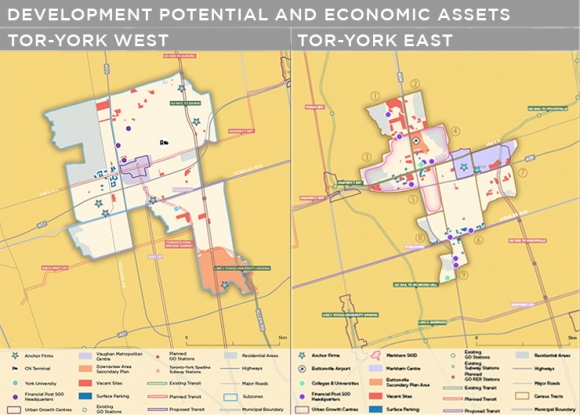June 1, 2017 - (TORONTO): New research for the Neptis Foundation shows that the Tor-York West and Tor-York East employment megazones - two large suburban employment areas in the Greater Toronto Area - have significant potential to create attractive and transit-supportive urban space for tens of thousands of new office workers.
These areas represent sizeable clusters of jobs, and have proved resilient during recent economic changes. Although both areas lost manufacturing jobs between 2001 and 2011, in Tor-York West, the losses led to an overall decline of only 0.4% in core employment (less than the decline for the region as a whole), while Tor-York East succeeded in attracting new finance and business services jobs to compensate for the losses, resulting in a 9% gain in total core employment. Such important economic assets need to be recognized in provincial and regional plans, but the megazones have long been ignored.
Please click on this link to access full profile of Tor-York West
Please click on this link to access full profile of Tor-York East

Changes in both megazones reflect broader economic trends in the region as its transition to a more knowledge-centred economy. "The growth of knowledge-intensive work is one of the key dynamics reshaping the employment geography of the Toronto region," says Pamela Blais, who conducted the research. "This change presents a significant opportunity to create denser, more attractive, more competitive employment districts in suburban megazones that can be better served by transit."
"Redevelopment on or near existing and planned transit in suburban employment megazones is critical to fostering economic development, reducing regional congestion, achieving Growth Plan objectives, and meeting provincial greenhouse gas reduction targets," says Blais.
The Province of Ontario is investing billions of dollars in rapid transit projects such as Bus Rapid Transit (BRT), all-day, two-way electrified GO Regional Express, and the extension of the University-Spadina subway line to Vaughan. Several key routes will pass through the megazones, representing an opportunity to reduce car traffic in and around these areas.
As Blais points out, "We need to focus on place-making and updating these districts to reflect the changing economy, attract knowledge economy jobs, and capitalize on transit investments."

As the starting point toward a more comprehensive re-urbanization strategy, Blais assessed the redevelopment potential of vacant sites and surface parking lots near existing and planned transit in these auto-dependent suburban megazones. At a conservative estimate, these lands could accommodate an additional 43,000 to 57,000 office workers, particularly in Markham in the Highway 404/Highway 7 area and along a stretch of Highway 7 west of the emerging Vaughan Metropolitan Centre (VMC).
"Realizing the potential of these areas means curbing the creation of new auto-dependent suburban office parks while attracting office development to existing centres and corridors that are already transit-accessible," says Blais.

Blais's analysis for the Neptis Foundation is part of a larger project to study the three large suburban employment megazones and five Suburban Knowledge-Intensive Districts (SKIDs) identified in a 2015 Neptis study, Planning for Prosperity: Globalization, Competitiveness, and the Growth Plan for the Greater Golden Horseshoe. This work builds on Blais's 2016 analysis of the megazone surrounding Pearson Airport, the second-largest employment area in Canada after downtown Toronto.
The research involved mapping the evolving employment geography of each megazone and analysing the dynamics of long-term structural changes - not merely cyclical market fluctuations - brought about by globalization and rapidly evolving technology in the Ontario economy.
Like downtown Toronto, the megazones and SKIDs contain a high proportion of "core" jobs, that is, jobs in the "tradeable" sectors that draw income into the region and are key to innovation and competitiveness in the regional economy.
Marcy Burchfield, Executive Director of the Neptis Foundation, notes that this work has the potential to inform the development of a regional employment strategy and the implementation of the recently released 2017 Growth Plan for the Greater Golden Horseshoe.
In particular, Burchfield points to language in the new Growth Plan that encourages municipalities to coordinate planning for large areas with high concentrations of employment that are significant trip generators and that cross municipal boundaries. "If the will is there," Burchfield says, "the new Growth Plan allows for the Province to identify areas that meet these criteria and provide direction for a coordinated approach to planning them."
For more information or media interviews, please contact Marcy Burchfield at 416-972-9199 (ext. 1) or 647-244-8413 or mburchfield@neptis.org
About Pamela Blais
Pamela Blais (MCIP, RPP, PhD) is an urban planner and principal of Metropole Consultants, her Toronto-based planning practice. Her professional focus is on creating better cities by integrating planning, economic, and environmental thinking in analysing urban issues and developing effective, innovative policy.
About the Neptis Foundation
The Neptis Foundation is an independent, privately capitalized charitable foundation located in Toronto, Ontario, that conducts and disseminates nonpartisan research, analysis and mapping on the design and function of Canadian urban regions.
